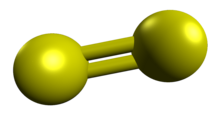Disulfur

| |

| |
| Names | |
|---|---|
| IUPAC name
Disulfur[1]
| |
| Systematic IUPAC name
Disulfene | |
| Other names
Diatomic sulfur
Sulfur dimer | |
| Identifiers | |
3D model (
JSmol ) |
|
| ChEBI | |
| ChemSpider | |
| 753 | |
PubChem CID
|
|
CompTox Dashboard (EPA)
|
|
| |
| |
| Properties | |
| S2 | |
| Molar mass | 64.12 g·mol−1 |
| 0 D | |
| Thermochemistry | |
Heat capacity (C)
|
32.51 kJ K−1 mol−1 |
Std molar
entropy (S⦵298) |
228.17 J K−1 mol−1 |
Std enthalpy of (ΔfH⦵298)formation |
128.60 kJ mol−1 |
| Related compounds | |
Related compounds
|
Triplet oxygen |
Except where otherwise noted, data are given for materials in their standard state (at 25 °C [77 °F], 100 kPa).
| |
Disulfur is the
Synthesis
This violet gas is generated by heating sulfur above 720 °C, comprising 99% of the vapor at low pressure (1 mm Hg) at 530 °C.
Disulfur can be produced when an atmosphere of COS is irradiated with UV light using a mercury photosensitizer or when CS2, H2S2, S2Cl2 or C2H4S, PSF3 or COS are irradiated.[4]
Natural occurrence
Gaseous disulfur has been detected emanating from the surface of Jupiter's moon Io, from the vicinity of Pele volcano.[5]
Properties
The ground state of S2 is a triplet: a diradical, with two unpaired electrons like O2 and SO. It has the S-S bond length of 189 pm, much shorter than the S-S single bonds in S8, which are 206 pm long. Its Raman spectrum consists of a band at 715 cm−1.[6] The corresponding O-O band for O2 is found at 1556 cm−1.[7] The S-S bond energy is 430 kJ/mol compared to 498 kJ/mol for O2.[8]
Disulfur readily photodissociates,[9] with a mean lifespan of 7.5 min in sunlight.[10]
References
- ^ ebi.ac.uk/chebi/searchId.do?chebiId=29387
- ISBN 978-3-540-40191-9.
- S2CID 121867974.
- .
- PMID 10817990.
- ISBN 978-3-540-40378-4.
- .
- ISBN 0-8493-0487-3.
- PMID 19754091.
- ISSN 0004-637X.
External links
 Media related to Disulfur at Wikimedia Commons
Media related to Disulfur at Wikimedia Commons
